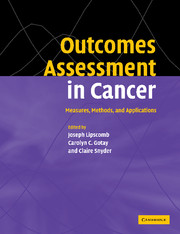Book contents
- Frontmatter
- Contents
- List of contributors
- Acknowledgments
- 1 Introduction to Outcomes Assessment in Cancer
- Health-related quality of life in cancer: general concepts and generic measures
- Assessing health-related quality of life during treatment
- Assessing health-related quality of life across the cancer continuum
- Measuring the experience and needs of cancer patients and caregivers
- Methodological considerations in applications to cancer outcomes research
- Modern psychometric theory in cancer outcomes research
- Assessing the economic impact of cancer
- Research and policy implications
- Invited papers
- Index
- References
1 - Introduction to Outcomes Assessment in Cancer
Published online by Cambridge University Press: 18 December 2009
- Frontmatter
- Contents
- List of contributors
- Acknowledgments
- 1 Introduction to Outcomes Assessment in Cancer
- Health-related quality of life in cancer: general concepts and generic measures
- Assessing health-related quality of life during treatment
- Assessing health-related quality of life across the cancer continuum
- Measuring the experience and needs of cancer patients and caregivers
- Methodological considerations in applications to cancer outcomes research
- Modern psychometric theory in cancer outcomes research
- Assessing the economic impact of cancer
- Research and policy implications
- Invited papers
- Index
- References
Summary
Understanding how a disease and its associated health care interventions affect the lives of individuals is important whatever the medical condition, but especially so for diseases that are chronic or incurable and for which treatments often have toxic and long-lasting consequences. For this reason, cancer provides an exceptionally compelling model for examining the impact of disease on individual well-being. It is the second leading cause of death in the US, with one out of every four deaths in 2004 (over 560 000 in total) projected to be attributable to cancer. Many more individuals (an estimated 9.6 million in 2000) will be undergoing cancer treatment, coping with progressive disease, or living cancer-free in the aftermath of diagnosis and treatment.
The principal means of treating cancer — surgery, chemotherapy, and radiation — are powerful and toxic. All of these treatments, and additional ones like hormonal therapy, have side effects, which may be short-term or time-limited, or chronic and persistent, or else generate late effects emerging only after treatment is completed and sometimes not evident until many years later. Efforts to prevent, screen for, and treat cancer are all aimed at maximizing the chances for a healthy life while, at the same time, minimizing the associated side effects. In addition to its mortality and morbidity impact, cancer inflicts an enormous economic burden on society.
- Type
- Chapter
- Information
- Outcomes Assessment in CancerMeasures, Methods and Applications, pp. 1 - 13Publisher: Cambridge University PressPrint publication year: 2004



